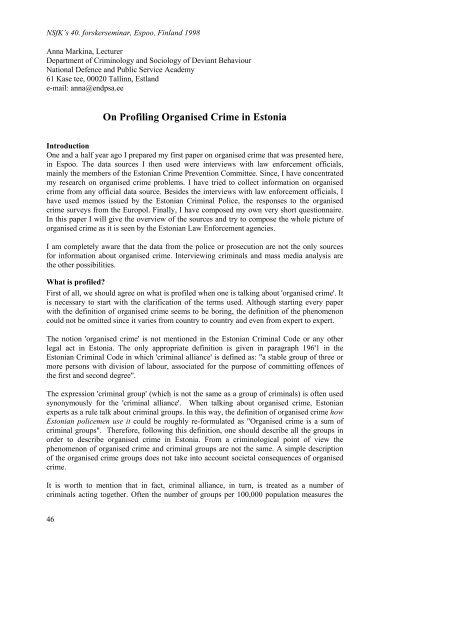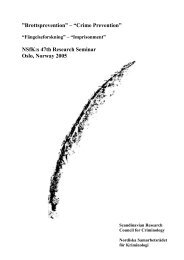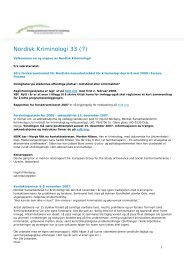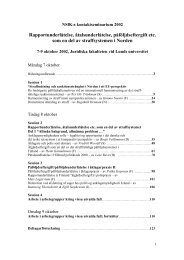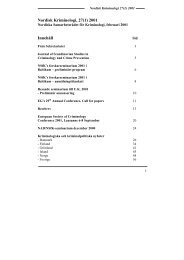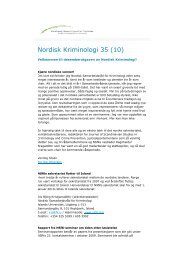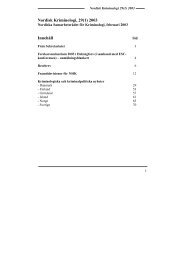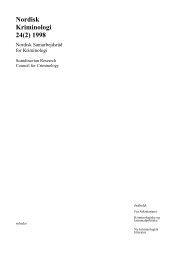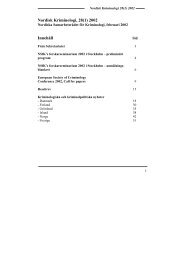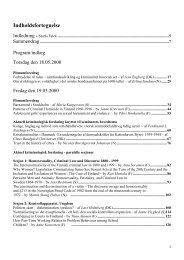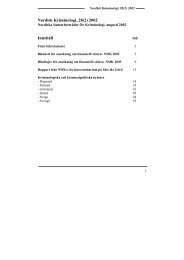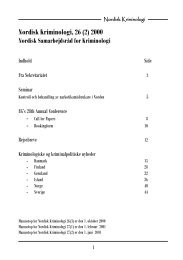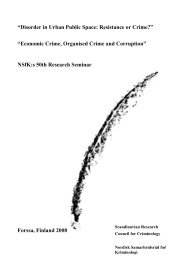Organised Crime & Crime Prevention - what works? - Scandinavian ...
Organised Crime & Crime Prevention - what works? - Scandinavian ...
Organised Crime & Crime Prevention - what works? - Scandinavian ...
Create successful ePaper yourself
Turn your PDF publications into a flip-book with our unique Google optimized e-Paper software.
NSfK’s 40. forskerseminar, Espoo, Finland 1998<br />
Anna Markina, Lecturer<br />
Department of Criminology and Sociology of Deviant Behaviour<br />
National Defence and Public Service Academy<br />
61 Kase tee, 00020 Tallinn, Estland<br />
e-mail: anna@endpsa.ee<br />
46<br />
On Profiling <strong>Organised</strong> <strong>Crime</strong> in Estonia<br />
Introduction<br />
One and a half year ago I prepared my first paper on organised crime that was presented here,<br />
in Espoo. The data sources I then used were interviews with law enforcement officials,<br />
mainly the members of the Estonian <strong>Crime</strong> <strong>Prevention</strong> Committee. Since, I have concentrated<br />
my research on organised crime problems. I have tried to collect information on organised<br />
crime from any official data source. Besides the interviews with law enforcement officials, I<br />
have used memos issued by the Estonian Criminal Police, the responses to the organised<br />
crime surveys from the Europol. Finally, I have composed my own very short questionnaire.<br />
In this paper I will give the overview of the sources and try to compose the whole picture of<br />
organised crime as it is seen by the Estonian Law Enforcement agencies.<br />
I am completely aware that the data from the police or prosecution are not the only sources<br />
for information about organised crime. Interviewing criminals and mass media analysis are<br />
the other possibilities.<br />
What is profiled?<br />
First of all, we should agree on <strong>what</strong> is profiled when one is talking about 'organised crime'. It<br />
is necessary to start with the clarification of the terms used. Although starting every paper<br />
with the definition of organised crime seems to be boring, the definition of the phenomenon<br />
could not be omitted since it varies from country to country and even from expert to expert.<br />
The notion 'organised crime' is not mentioned in the Estonian Criminal Code or any other<br />
legal act in Estonia. The only appropriate definition is given in paragraph 196'1 in the<br />
Estonian Criminal Code in which 'criminal alliance' is defined as: "a stable group of three or<br />
more persons with division of labour, associated for the purpose of committing offences of<br />
the first and second degree".<br />
The expression 'criminal group' (which is not the same as a group of criminals) is often used<br />
synonymously for the 'criminal alliance'. When talking about organised crime, Estonian<br />
experts as a rule talk about criminal groups. In this way, the definition of organised crime how<br />
Estonian policemen use it could be roughly re-formulated as "<strong>Organised</strong> crime is a sum of<br />
criminal groups". Therefore, following this definition, one should describe all the groups in<br />
order to describe organised crime in Estonia. From a criminological point of view the<br />
phenomenon of organised crime and criminal groups are not the same. A simple description<br />
of the organised crime groups does not take into account societal consequences of organised<br />
crime.<br />
It is worth to mention that in fact, criminal alliance, in turn, is treated as a number of<br />
criminals acting together. Often the number of groups per 100,000 population measures the


